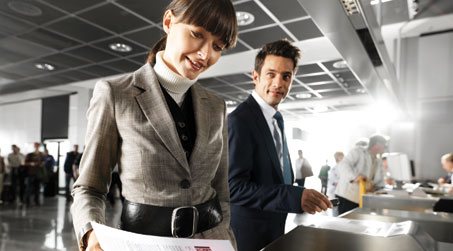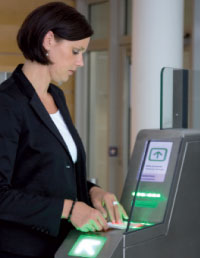
Lengemann: “All participants benefit from the operation of self-boarding, since the identification process at the boarding point is so fast.” (© Photographer: Wunderman, Frankfurt - © Models: Wunderman, Frankfurt).
Lufthansa’s long history of self-boarding dates back to 1997, when it became the first airline to implement self-boarding turnstiles, and six years later the first Quick-Boarding-Gates (QBGs) were introduced at Munich Airport. Since then, they have been introduced at Frankfurt, Düsseldorf and Hamburg, while the former has more recently become the first airport to utilise the second-generation of the self-service facility.
The QBGs work by allowing passengers to self-scan their boarding pass at the gate. After a short verification process, the gate is released and if the passenger’s seat allocation has changed at short notice, a new coupon is automatically printed with the updated information.
“All participants benefit from the operation of self-boarding, since the identification process at the boarding point is so fast,” said Ulf Lengemann, Lufthansa’s Senior Manager Gate Processes. “It’s a win-win situation for all parties involved.”
Following positive feedback on the implementation of the latest QBGs in Frankfurt, the airline is now exploring further installations.
Lengemann said: “We plan to introduce the new QBGs in Düsseldorf and we hope to get more airports to invest in QBGs and offer them to the airlines to use.” This, he said, would have to be a “club decision”, which is undertaken for the mutual benefit of everyone involved.
Global appeal
The concept of self-boarding is not unique to Lufthansa. In July last year, Continental Airlines launched a self-boarding trial at Houston Airport – the first of its kind in the US – while South Korea’s Incheon International Airport has also offered self-boarding as part of its wide-reaching ‘u-Airport’ self-service concept since 2008.
The latest version of Incheon International Airport Corporation’s (IIAC) product utilises e-Passports and facial recognition biometric technology, removing the need for a boarding pass altogether and reducing the passenger boarding process to just 13 seconds.
While Lufthansa plans to add to the 15 next-generation QBGs that are already in use, Lengemann explained that he expects self-boarding to become a more common phenomenon in the near-term on a wider scale.
“We expect self-boarding to become an industry standard, and will be integrated in the airport infrastructure of most airports – at least the major airports,” he concluded.
MATERNA’s Integrated Passenger Services

MATERNA has expanded its portfolio with the addition of a self-boarding gate, which is designed to optimise the aircraft boarding process.
“Simplifying the passengers’ journey is our main objective,” said Reinhard Augustin, international sales manager at MATERNA in Germany. “We see great potential at international airports for more efficiency. With our products we focus on cost reduction, reliability, service and security optimisation.”
In the 1980s, MATERNA was a pioneer in developing the first CUTE solutions and since then, the company has played an important role while setting and defining CUSS (Common Use Self Service) standards in conjunction with the International Air Transport Association (IATA).
Following this motivation, MATERNA launched its Integrated Passenger Services for check-in, baggage drop off, security and boarding.
Today, MATERNA integrates new technologies, like biometrics, RFID and NFC in order to simplify the passenger’s journey of tomorrow. Innovative baggage drop-off and secure access solutions meet future challenges. MATERNA’s ‘SecureAccess’ provides passenger access to any kind of restricted area in the airport environment.
As a leading supplier of CUSS solutions, MATERNA has expanded its portfolio with a self-boarding gate, which optimises the aircraft boarding process significantly. It allows fully automated boarding including all necessary validation and reporting to airline DCS.
Augustin added: “Besides our own certified employees, we have a strong partner network in Europe and EMEA, which helps us to fulfil customer requirements quickly and reliably.”







